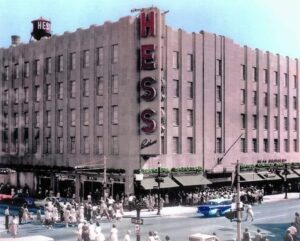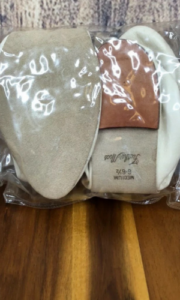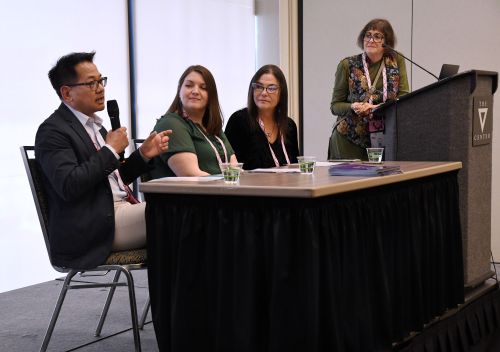by Anne Cecil, Owner and Founder of Ono and instructor at the MSA FORWARD Nonprofit Retail Boot Camp
I have loved retail as long as I can remember. Childhood memories include trips to Hess’s in Allentown, PA. As a small child, I had lunch in the restaurant that offered multi-color crystal sugar and LIVE fashion shows. The models carried cards with the designer’s names and the floor where they were located. Turns out the signature sugar and lunch time fashion shows were marketing devices designed to create the Hess’s experience. The sugar was a stroke of merchandising genius. It was a unique take on a familiar product. The multi colors attracted the eye, but even more importantly it connected to taste, one of the hardest senses to engage in a retail store. If I remember correctly, it was also for sale as a Hess’s exclusive, an early example of private label that gained ground in the late 1980s to offer exclusive products yielding higher margins that competed with vendor brands.
 I can still see the sweeping circular drive from Lancaster Avenue up to B. Altman’s in Radnor, PA, a beacon filled with delights at the top of a hill. Today, we retailers call this the approach, and it is immensely important to retail success. The front and façade are the face of the store. Attention to detail is key to setting the customer’s expectation for what is inside. This was a free-standing store that, like the grand houses of earlier times, overlooked the kingdom. The store windows were clean and designed as large billboards, easy to understand as we drove by to park. The façade was immaculate, clean, and in pristine repair. The parking lot and landscaping were well-kept, swept, and attended to on the regular. The door was weather-protected with an awning. There were double doors, allowing the customer to adjust and prepare to shop in comfort. These tasks fall under the operations function in retail and are crucial in setting the first impression.
I can still see the sweeping circular drive from Lancaster Avenue up to B. Altman’s in Radnor, PA, a beacon filled with delights at the top of a hill. Today, we retailers call this the approach, and it is immensely important to retail success. The front and façade are the face of the store. Attention to detail is key to setting the customer’s expectation for what is inside. This was a free-standing store that, like the grand houses of earlier times, overlooked the kingdom. The store windows were clean and designed as large billboards, easy to understand as we drove by to park. The façade was immaculate, clean, and in pristine repair. The parking lot and landscaping were well-kept, swept, and attended to on the regular. The door was weather-protected with an awning. There were double doors, allowing the customer to adjust and prepare to shop in comfort. These tasks fall under the operations function in retail and are crucial in setting the first impression.
Each year, I would go to our local John Wanamaker’s with my mother as she chose foldable hostess slippers that she would pop  in her handbag to wear for various social events. I would peruse the clear plastic bags merchandised by style and size hooked onto slat walls, imagining the day I would be old enough to get my own. These slippers have become a huge inspiration in my shoe-making business. It is interesting to note that the classification of these foldable shoes as slippers was intentional. It made them subject to less tariff and tax than the classification of shoes, allowing buyers to acquire a value category for less investment. It is interesting to note that various vendors are pursuing re-classification to combat the potential tariffs today.
in her handbag to wear for various social events. I would peruse the clear plastic bags merchandised by style and size hooked onto slat walls, imagining the day I would be old enough to get my own. These slippers have become a huge inspiration in my shoe-making business. It is interesting to note that the classification of these foldable shoes as slippers was intentional. It made them subject to less tariff and tax than the classification of shoes, allowing buyers to acquire a value category for less investment. It is interesting to note that various vendors are pursuing re-classification to combat the potential tariffs today.
As an adult, I worked at Bloomingdale’s, where each year, we featured a foreign country presenting products in outpost shops throughout the store. Part of the event included a limited number of signature shopping bags featuring artwork reflecting the spotlight country. I will never forget the physical fights that would break out on the sales floor when we got to the final few. Often, the fights ended without a winner. The bag was ripped to shreds during the fray! On weekends, we hosted live mannequins in our glass walls. The models were very good at staying still. It was fascinating watching the customers’ tension build and the collective delight when the pose changed. These marketing tactics were integral in defining Bloomingdale’s brand experience.
What I really love is Retail Theater. It is what lead me to pursue a career in retail, design and merchandising and ultimately to teach others about the field. I’ve been doing so since 1988. Over time, retail has changed a lot and not at all. The fundamentals remain unchanged, but the formats and communication channels have changed. That’s what keeps it interesting.
MSA Boot Camp is one opportunity for me to teach the nuts and bolts of retail operations that accurately address the complexities of Museum and Institutional retail that are not found in the traditional retail store. Together with MSA institutional members Ione Saroyan, New-York Historical Society, Stuart Hata, Fine Arts Museums of San Francisco, Aubrey Herr, The Morgan Library & Museum, and Kirsten Parker from Golden Spike Tower, we’ll share the fundamental functions of a retail store operation, insights into work as a nonprofit retail professional and the benefits of being an active member of MSA. You will leave the session with the tools to run your store and advocate for you and your department institutionally. It’s the gateway to loving retail!

Professional retail educator, Anne Cecil, will teach MSA Boot Camp again this year. She will focus on the pillars of museum store management inspired by Museum Store Association’s Knowledge Standards to help you get your financial ducks in a row, learn inventory control, leadership and team building, merchandising and customer service.

